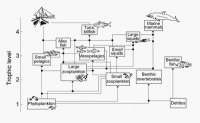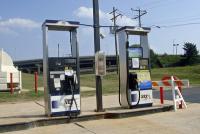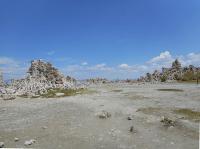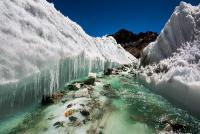-
Hunger levels “serious” or “alarming” in 52 developing countries: Report
Despite progress in reducing hunger worldwide, hunger levels in 52 of 117 countries in the 2015 Global Hunger Index remain “serious” (44 countries) or “alarming” (8 countries). The Central African Republic, Chad, and Zambia had the highest hunger levels in the report, which was released last week. Conflicts can be strongly associated with severe hunger, according to the report, which focused on armed conflict and the challenge of hunger.
-
-
Global marine analysis: Food chain collapse likely

A world-first global analysis of marine responses to climbing human CO2 emissions has painted a grim picture of future fisheries and ocean ecosystems. Marine ecologists say the expected ocean acidification and warming is likely to produce a reduction in diversity and numbers of various key species that underpin marine ecosystems around the world. The researchers found that there would be “limited scope” for acclimation to warmer waters and acidification. Very few species will escape the negative effects of increasing CO2, with an expected large reduction in species diversity and abundance across the globe.
-
-
Former peanut company owner to jail for 28 years for fatal 2009 salmonella outbreak
In a rare instance of a prison sentence in a food contamination case, Stewart Parnell, the former owner of Peanut Corporation of America, was sentenced to twenty-eight years in prison for his role in a 2009 salmonella outbreak which killed nine people and sickened hundreds. Parnell, 61, who once managed the Peanut Corporation of America, and his brother, Michael Parnell, who was a food broker for the company, were convicted on Monday on federal conspiracy charges for knowingly shipping salmonella-tainted peanuts to customers.
-
-
Rather food versus fuel, think in terms of both food and fuel

Whether you have taken a side or a backseat in the discussion, the “food versus fuel” debate affects us all. Some say growing more biofuel crops today will decrease greenhouse gas emissions, but will make it harder to produce food tomorrow, which has prevented the United States from maximizing the potential of environmentally beneficial biofuels. Scientists argue that farmers can sustainably, and affordably, meet humanity’s growing demand for food and fuel.
-
-
2015 drought costs for California agriculture: Loss of $1.84 billion, 10,100 jobs

The drought is tightening its grip on California agriculture, squeezing about 30 percent more workers and cropland out of production than in 2014, according to the latest drought impact report. In 2015, the state’s agricultural economy will lose about $1.84 billion and 10,100 seasonal jobs because of the drought, the report estimated, with the Central Valley hardest hit. The heavy reliance on groundwater comes at ever-increasing energy costs as farmers pump deeper and drill more wells. Some of the heavy pumping is in basins already in severe overdraft — where groundwater use greatly exceeds replenishment of aquifers — inviting further land subsidence, water quality problems, and diminishing reserves needed for future droughts.
-
-
Repurposing wasted food would feed the hungry, create jobs
Roughly one third of all global food gets wasted. In the United States, that number is even higher, with nearly 40 percent of all food going to waste, making it one of the most wasteful countries in the world. Researchers have developed a new model for recovering would-be wasted — or surplus — food and repurposing it to feed hungry people, generate revenue, and even create jobs. The model — Food System-Sensitive Methodology (FSSM) — was recently piloted in West Philadelphia. The researchers say that applying FSSM nationally would likely yield about 1.1 billion pounds of recovered wasted food annually.
-
-
EU-funded research: Climate change and food safety
The global fresh produce supply chain must take into account climate change in order to ensure food safety, warn EU-funded researchers. This was the key recommendation of the EU-funded VEG-I-TRADE project, which was launched in 2010 to assess the safety of fresh produce in a rapidly evolving context of climate change and expanding international trade.
-
-
Warming-driven substantial glacier ice loss in Central Asia imperils water supplies

Central Asia is the outstanding case for human dependence on water seasonally delayed by glaciers. Nowhere the question about the glacier state is linked so closely to questions of water availability and, thus, food security. The glaciers in Central Asia, however, experience substantial losses in glacier mass and area. Along the Tien Shan, Central Asia’s largest mountain range, glaciers have lost 27 percent of their mass and 18 percent of their area during the last fifty years. Scientists estimate that almost 3,000 square kilometers of glaciers and an average of 5.4 gigatons of ice per year have been lost since the 1960s, saying that about half of Tien Shan’s glacier volume could be depleted by the 2050s.
-
-
Agroterrorism a serious risk to Americans, U.S. economy: Experts
The word “terrorism” is typically associated with bomb and bullets, but security experts say that there are other types of terrorism which may bring death and disruption, chief among them is agroterrorism. Agroterrorism is the use of animal or plant pathogens to disrupt a nation’s food supply, or use the food supply to spread deadly disease.In 2004, Tommy Thompson, then secretary of Health and Human Services, said that, “For the life of me, I cannot understand why the terrorists have not attacked our food supply, because it is so easy to do.”
-
-
Accelerometers embedded in ear tags detect disease in beef cattle
A smartphone switches its orientation from portrait to landscape depending on how it’s tilted. A car’s airbags inflate when it senses collision forces. By detecting earth’s vibrations, a computer can measure the magnitude and aftershocks of an earthquake. These technologies are made possible by accelerometers — small, electromechanical devices that measure acceleration. The devices are able to detect the most sensitive of motions, from the number of steps taken during a morning walk to the number of jaw movements during a heifer’s morning meal. In fact, some dairy producers use these devices to measure feed intake, detect heat and notably, identify sick animals.
-
-
Drones contribute to improving crops
Researchers have used a drone to measure the temperature, humidity, luminosity, and carbon dioxide concentration in a greenhouse. The capacity of an aerial vehicle to move in three-dimensional space, and the possibility to place the sensor at any point, have clear advantages compared to other alternatives such as sensor networks. By building maps of environmental variables, the drones could help achieve optimal conditions for plant growth.
-
-
If global warming is left unchecked, fish will have to find new habitats -- or perish
The goods and services our oceans provide are valued at hundreds of billions of dollars per year. A new study assessed the impact of climate change on marine and coastal ecosystems, ocean chemistry, tourism, and human health. The study specifically analyzed how warming will impact fisheries and the global economic gains we receive from these fisheries. It found that Climate change is forcing fish out of their current habitats and into cooler waters and many more species will soon be affected if climate goals are not met. “From looking at the surface of the ocean, you can’t tell much is changing,” said one researcher. “The oceans are closely tied to human systems and we’re putting communities at high risk.”
-
-
Rising fossil fuel energy costs risk global food security
Ongoing efforts to feed a growing global population are threatened by rising fossil-fuel energy costs and breakdowns in transportation infrastructure. Without new ways to preserve, store, and transport food products, the likelihood of shortages looms in the future. In an analysis of food preservation and transportation trends, scientists warn that new sustainable technologies will be needed for humanity just to stay even in the arms race against the microorganisms that can rapidly spoil the outputs of the modern food system.
-
-
Muzzle biometrics for cattle ID reduces food fraud
Meat products are currently a vital part of the global food supply, with beef being a major component of that trade. However, international markets, emerging infectious diseases, and criminal activity mean that there is always a risk of inferior products hitting the supermarket shelves. Researchers are developing a biometric identification system for cattle that could reduce food fraud and allow ranchers to control their stock more efficiently. The system uses the unique features of a prominent part of the animal to identify the beasts — their muzzles.
-
-
Precision agriculture: Sensors and drones as farmers’ best friends
The precision agriculture sector is expected to grow at a high rate over the coming years. This new way of farming is already a reality in northwest Italy, where technologies are being used to keep plants in a good state of health but also to avert the loss of quality yield. Sensors and drones can be among the farmers’ best friends, helping them to use less fertilizers and water, and to control the general condition of their crops.
-
- All
- Regional
- Water
- Biometrics
- Borders/Immig
- Business
- Cybersecurity
- Detection
- Disasters
- Government
- Infrastructure
- International
- Public health
- Public Safety
- Communication interoperabillity
- Emergency services
- Emergency medical services
- Fire
- First response
- IEDs
- Law Enforcement
- Law Enforcement Technology
- Military technology
- Nonlethal weapons
- Nuclear weapons
- Personal protection equipment
- Police
- Notification /alert systems
- Situational awareness
- Weapons systems
- Sci-Tech
- Sector Reports
- Surveillance
- Transportation
Advertising & Marketing: advertise@newswirepubs.com
Editorial: editor@newswirepubs.com
General: info@newswirepubs.com
2010-2011 © News Wire Publications, LLC News Wire Publications, LLC
220 Old Country Road | Suite 200 | Mineola | New York | 11501
Permissions and Policies
Editorial: editor@newswirepubs.com
General: info@newswirepubs.com
2010-2011 © News Wire Publications, LLC News Wire Publications, LLC
220 Old Country Road | Suite 200 | Mineola | New York | 11501
Permissions and Policies
